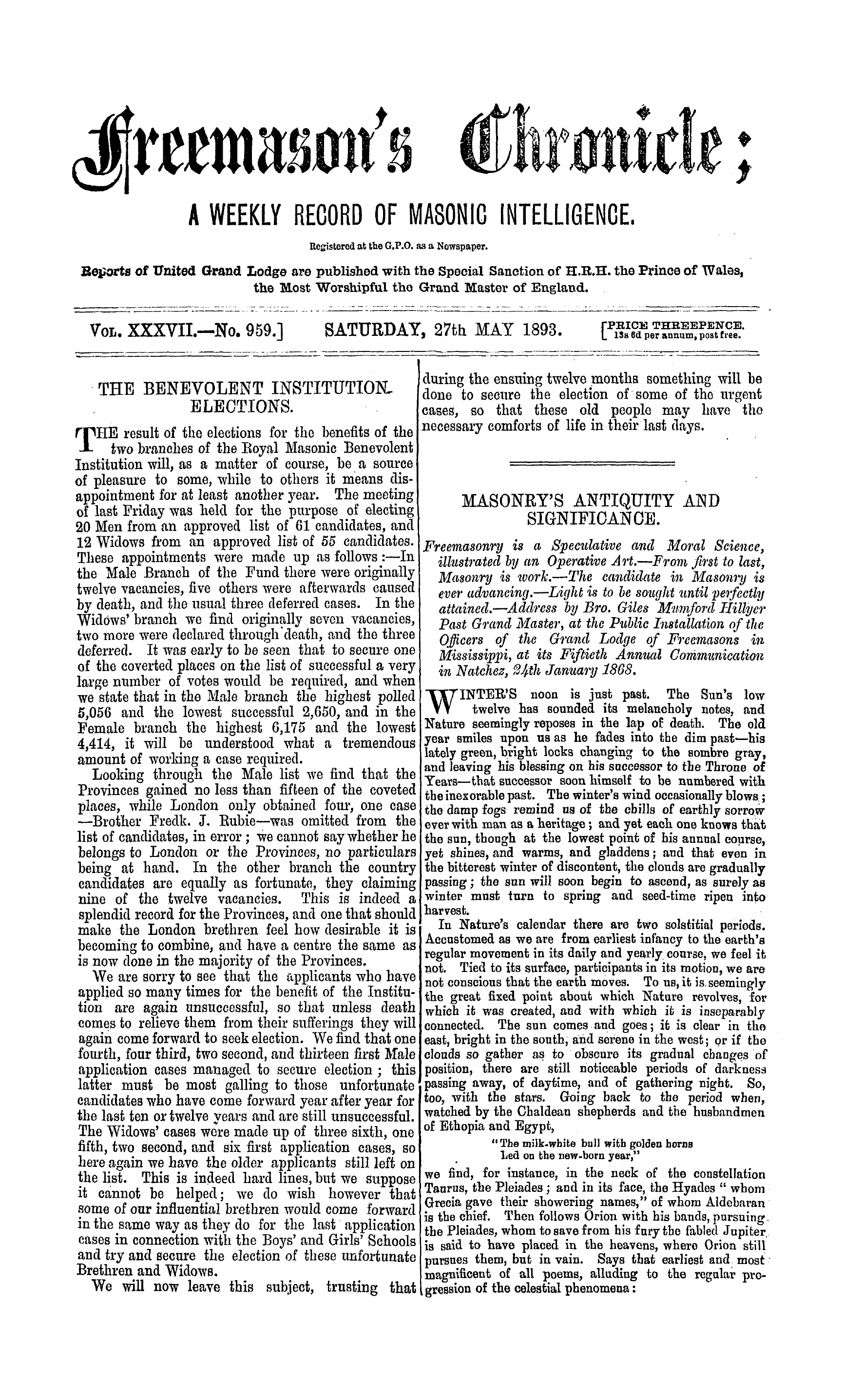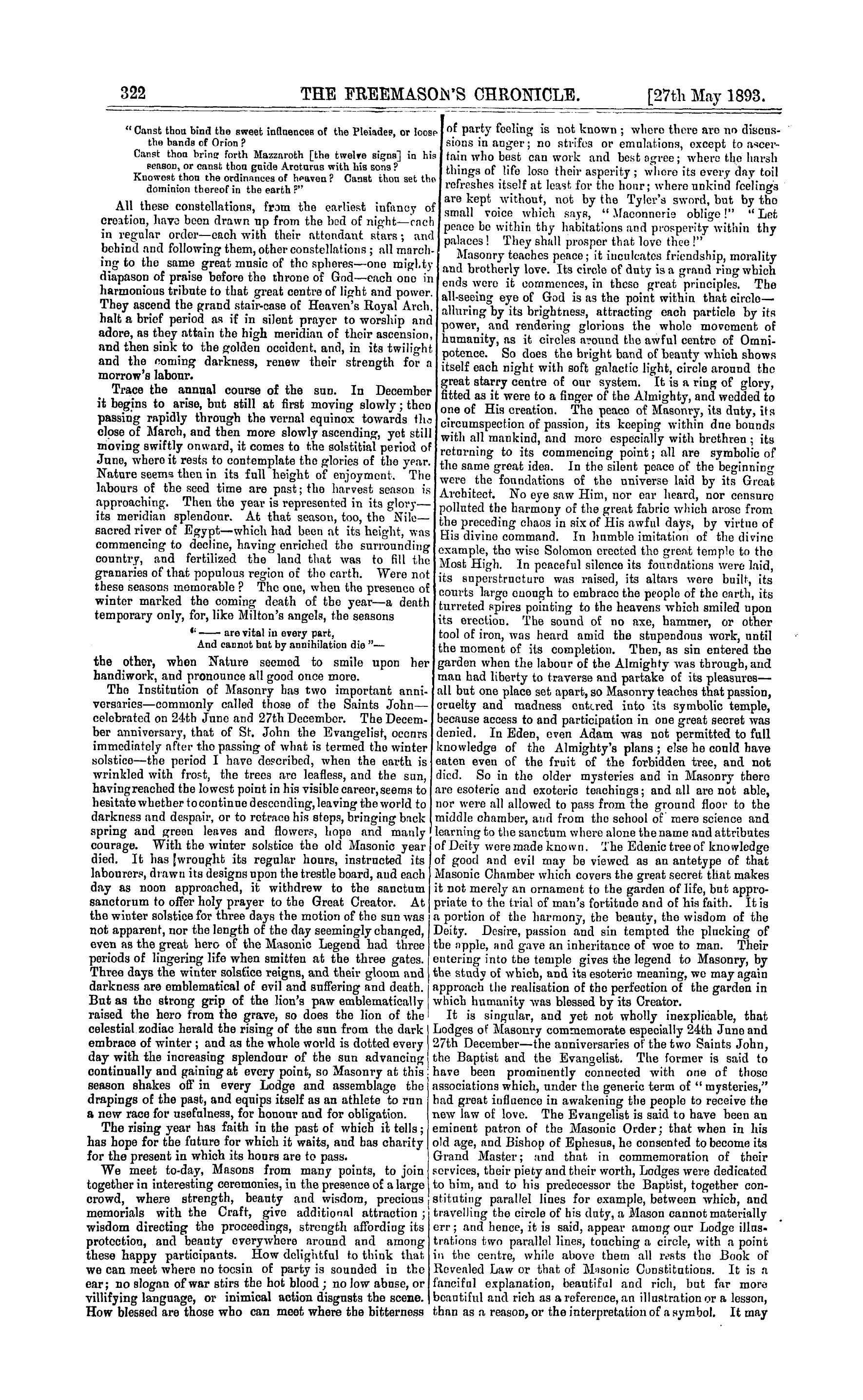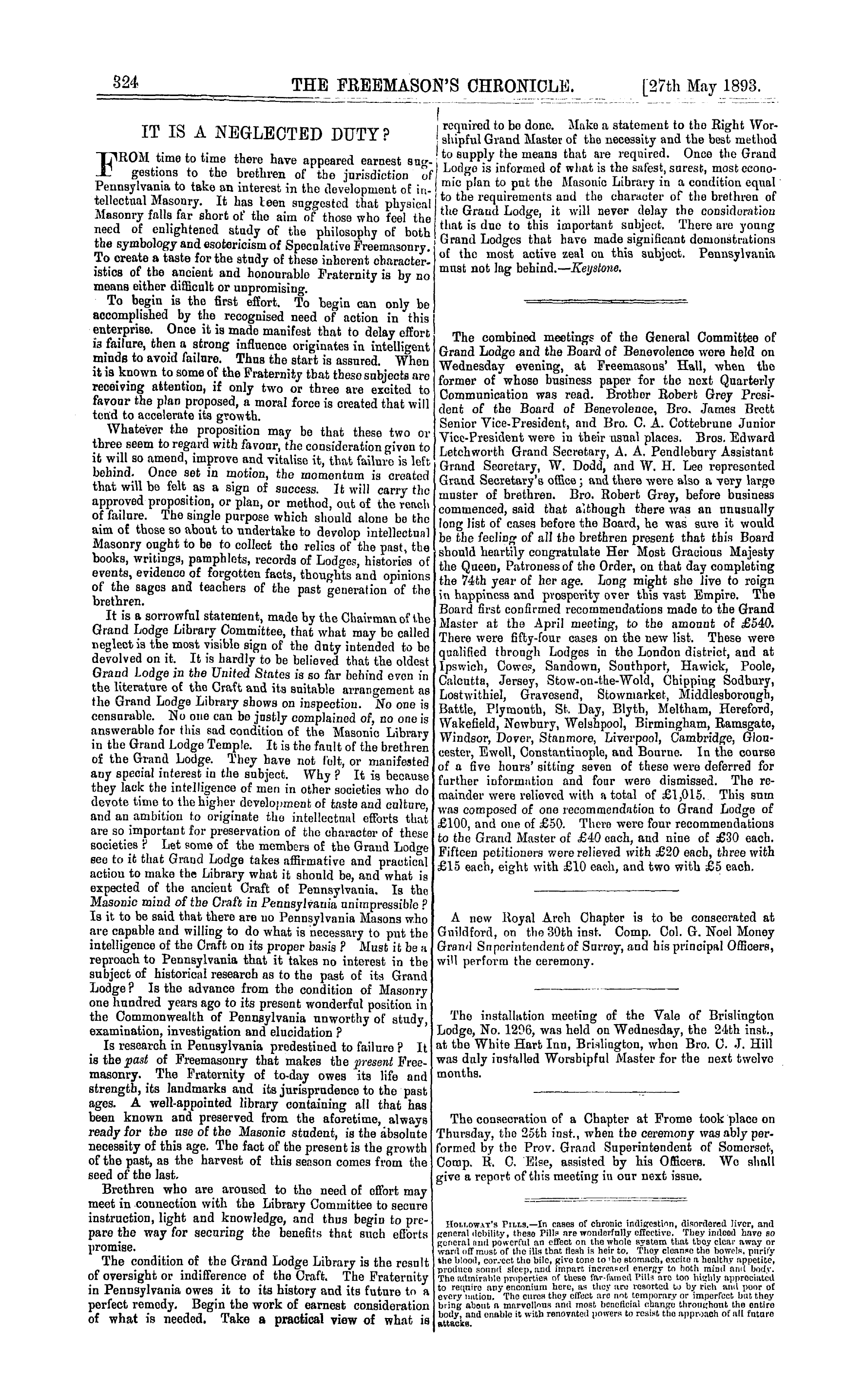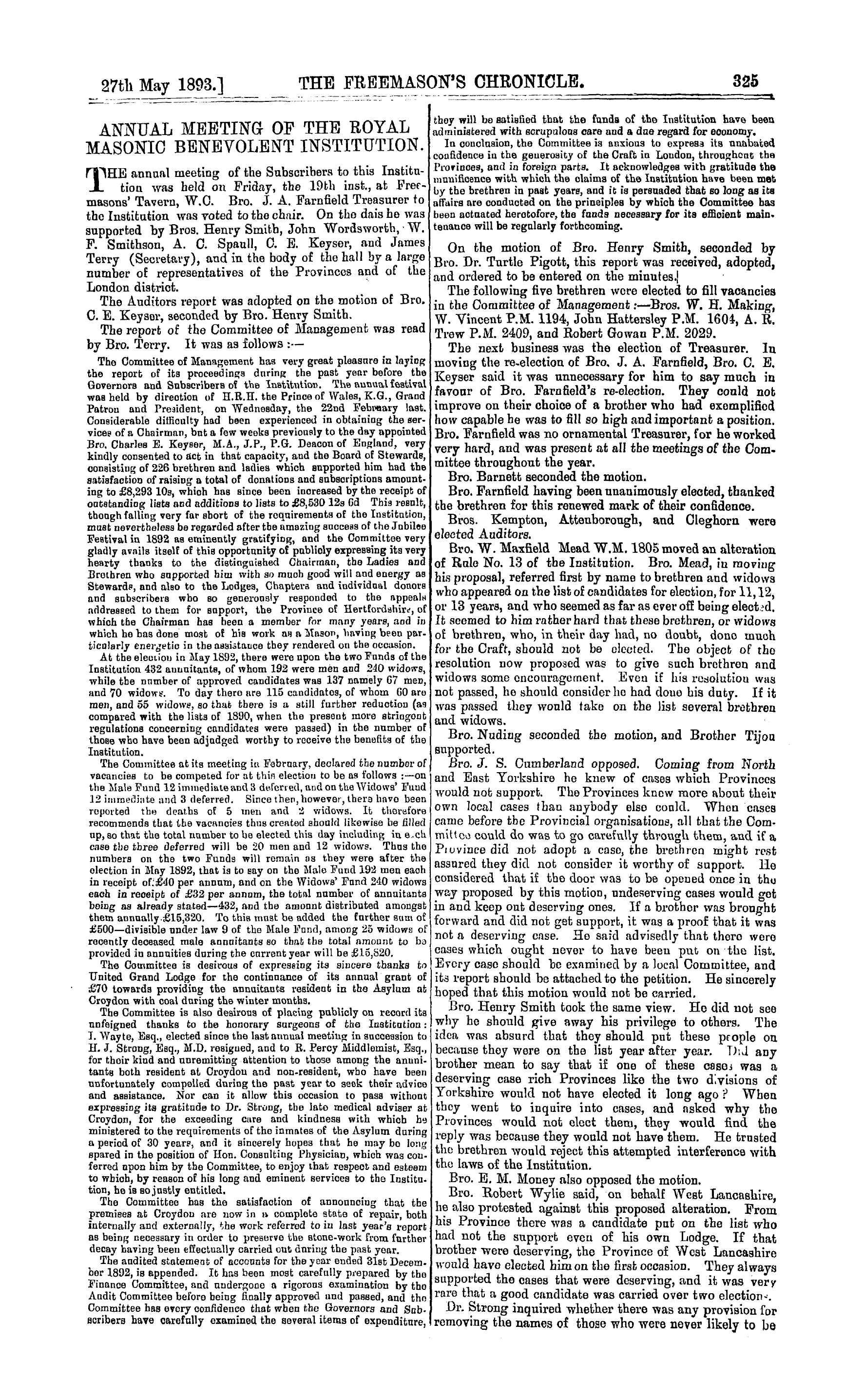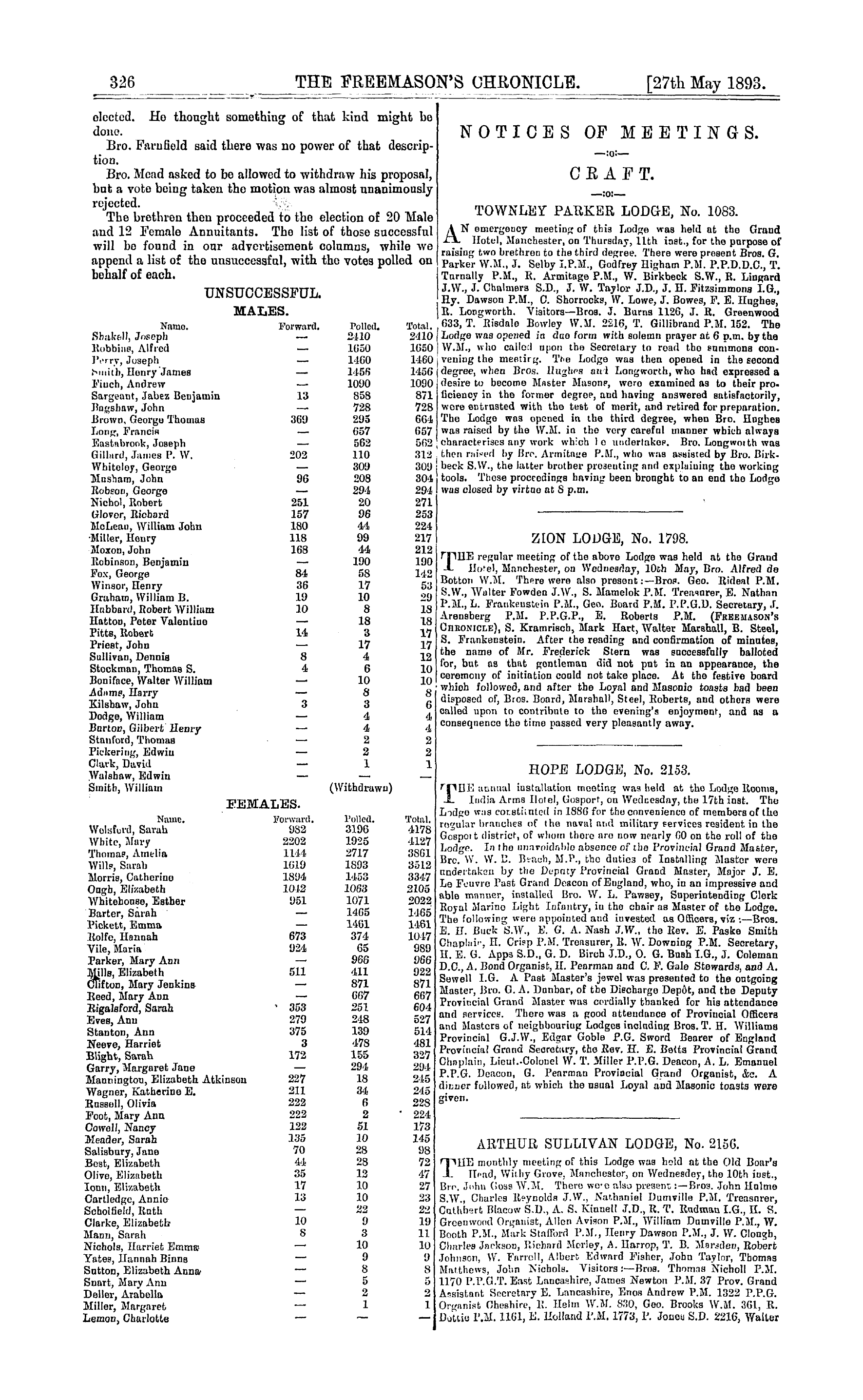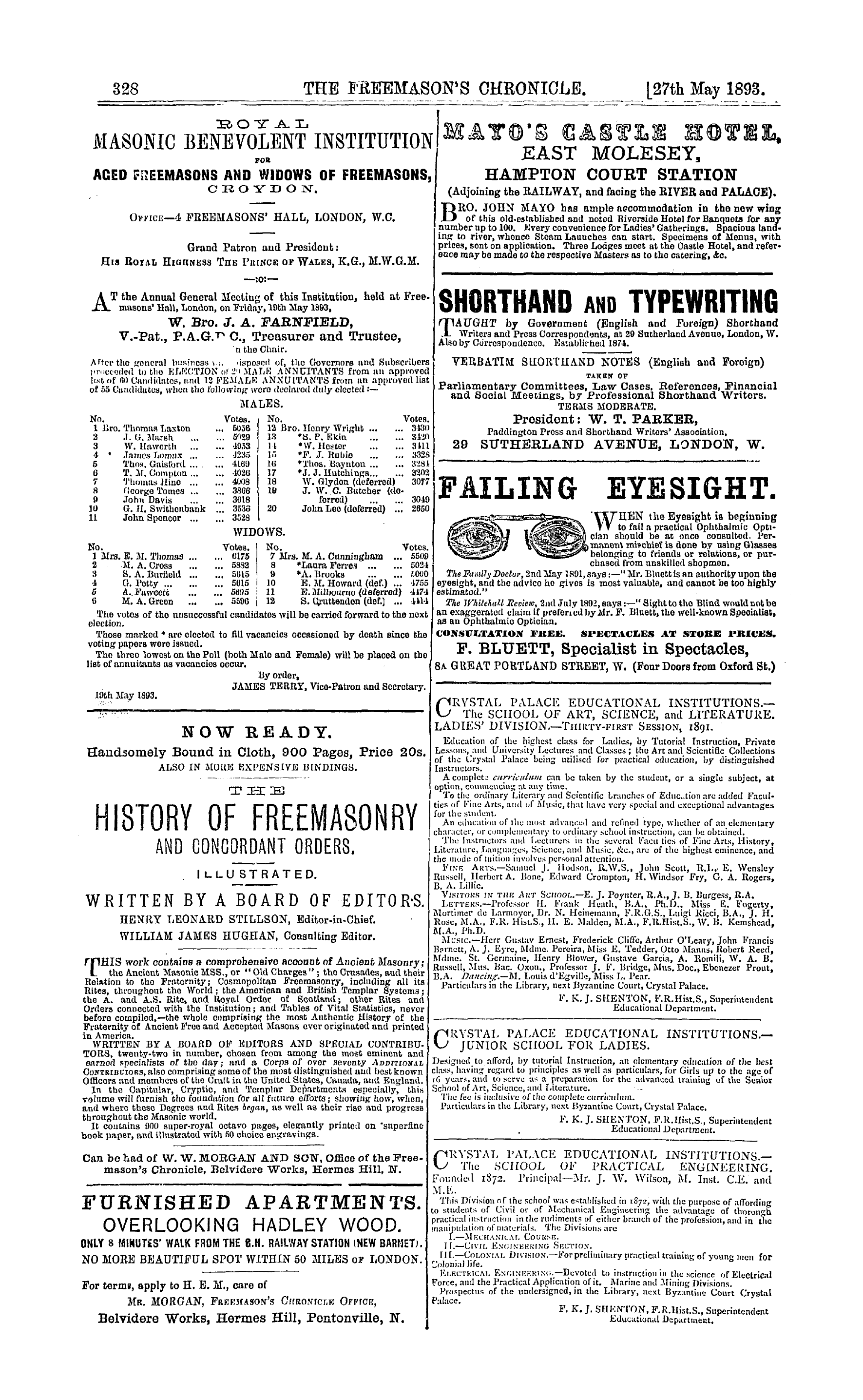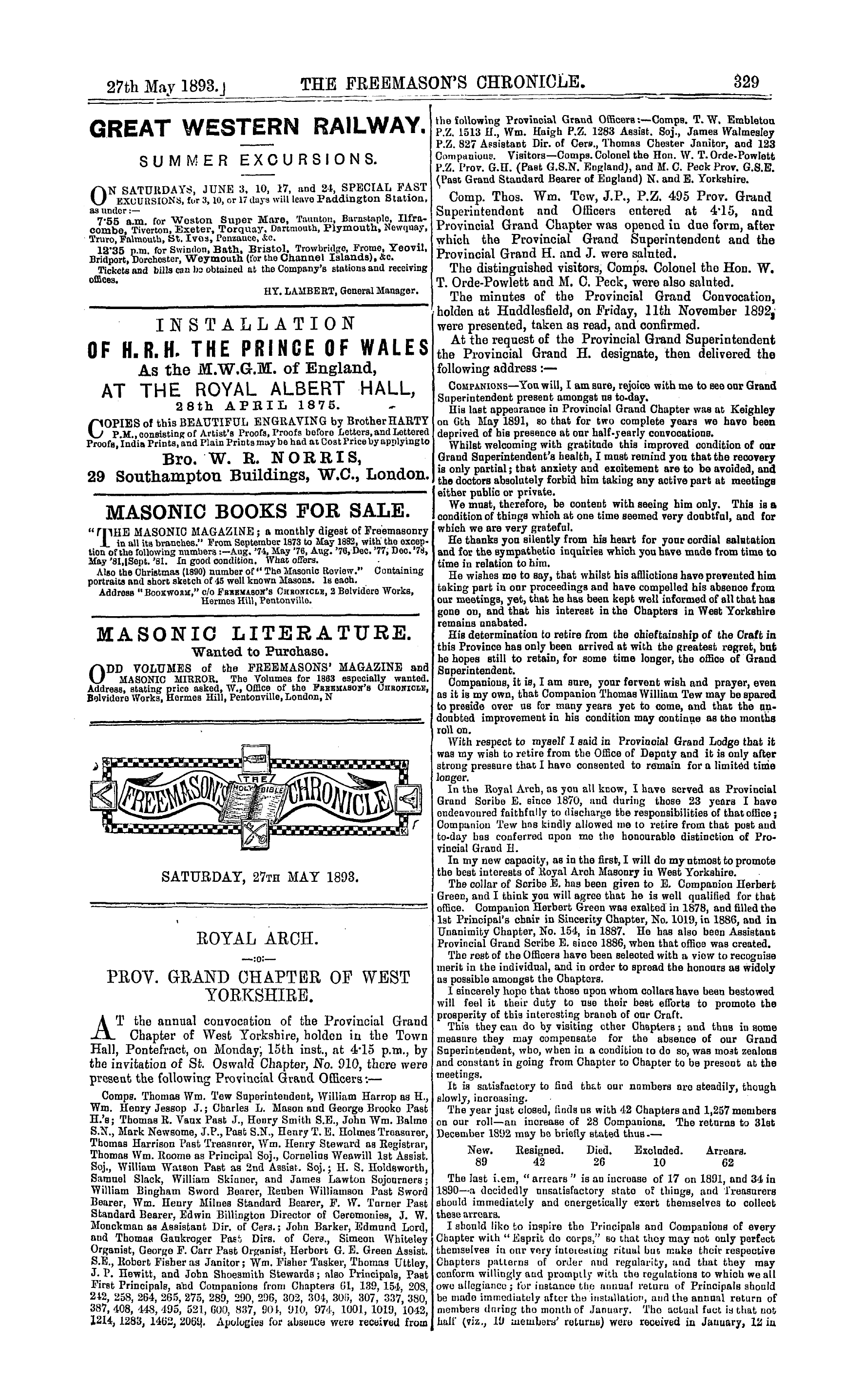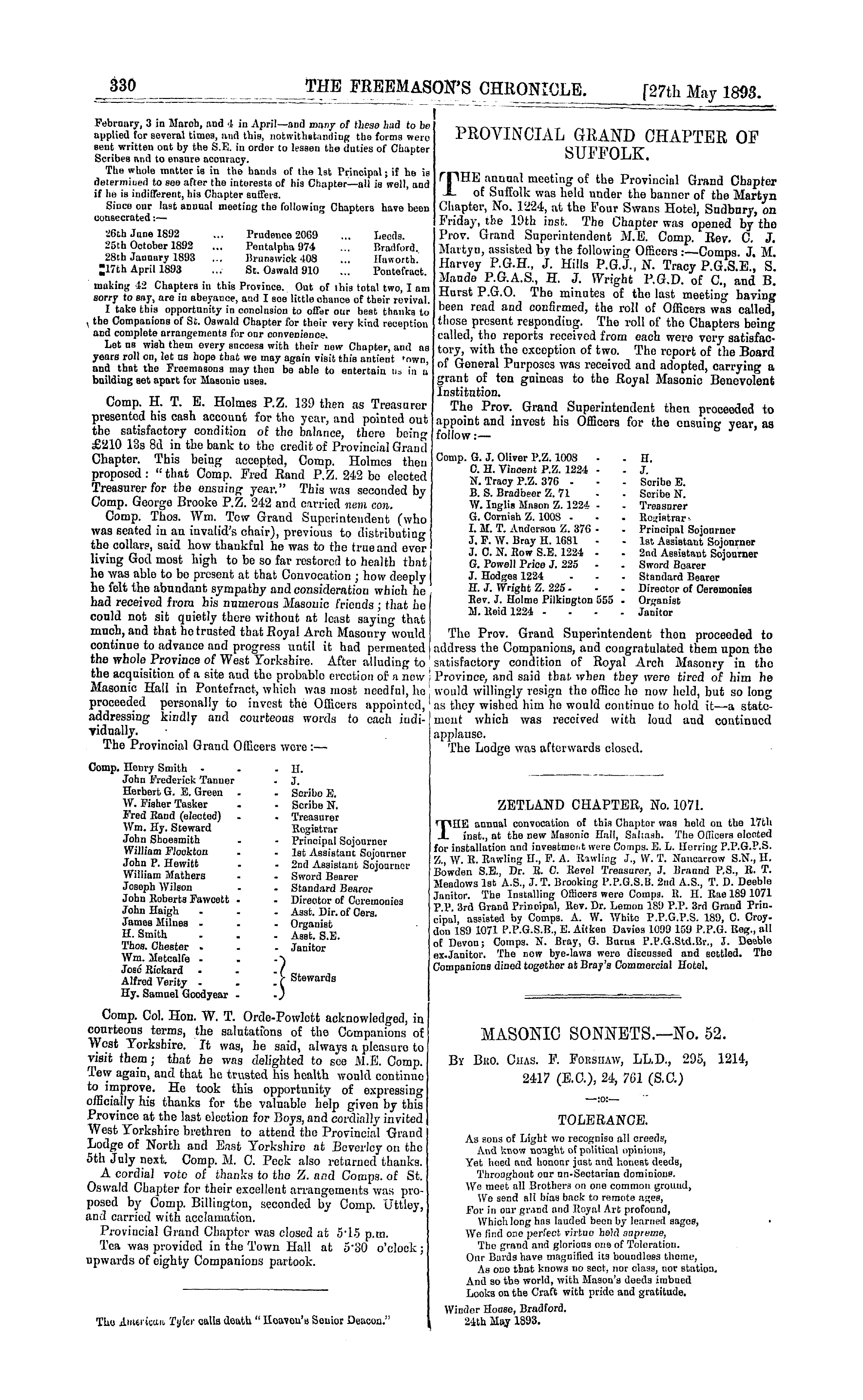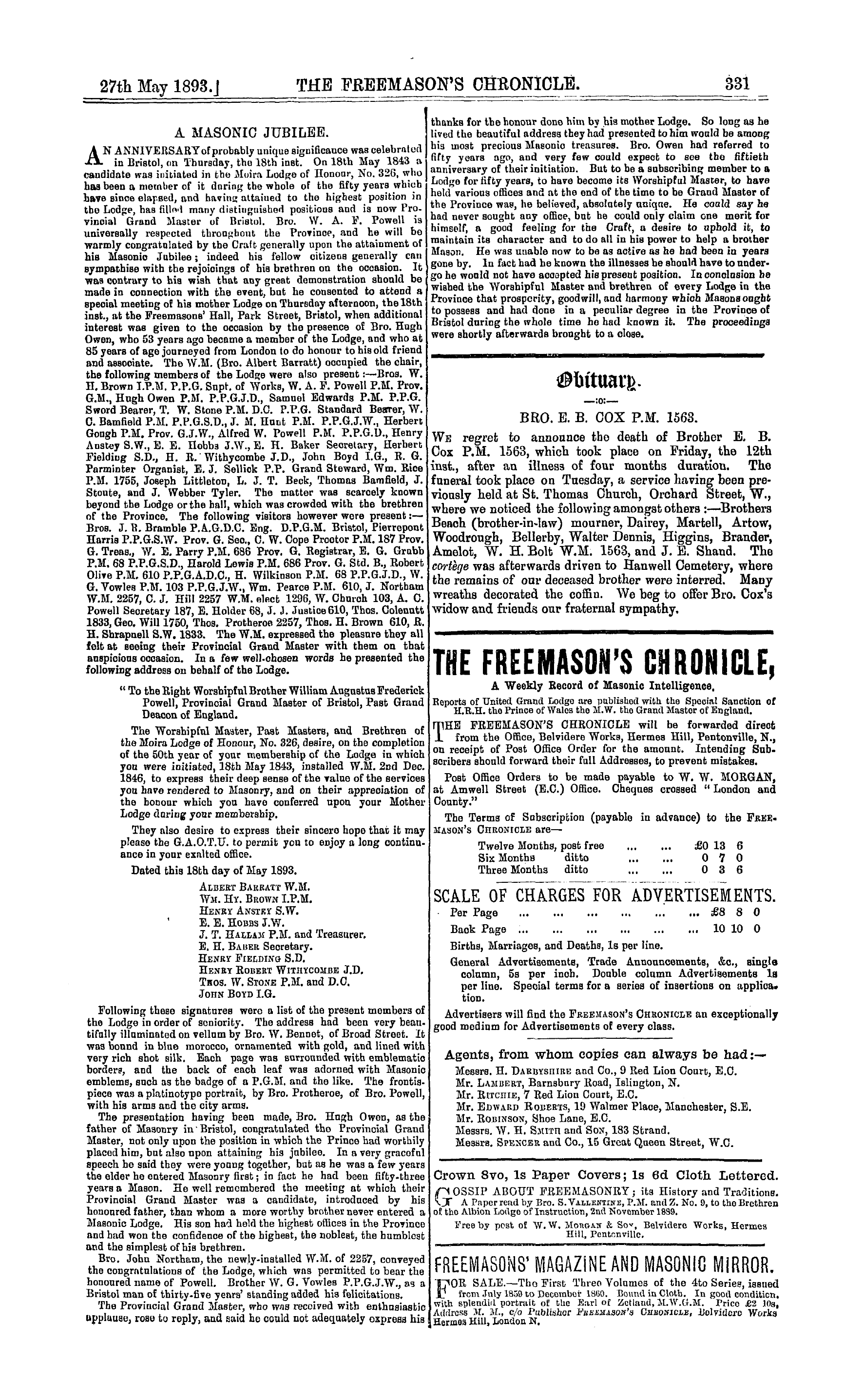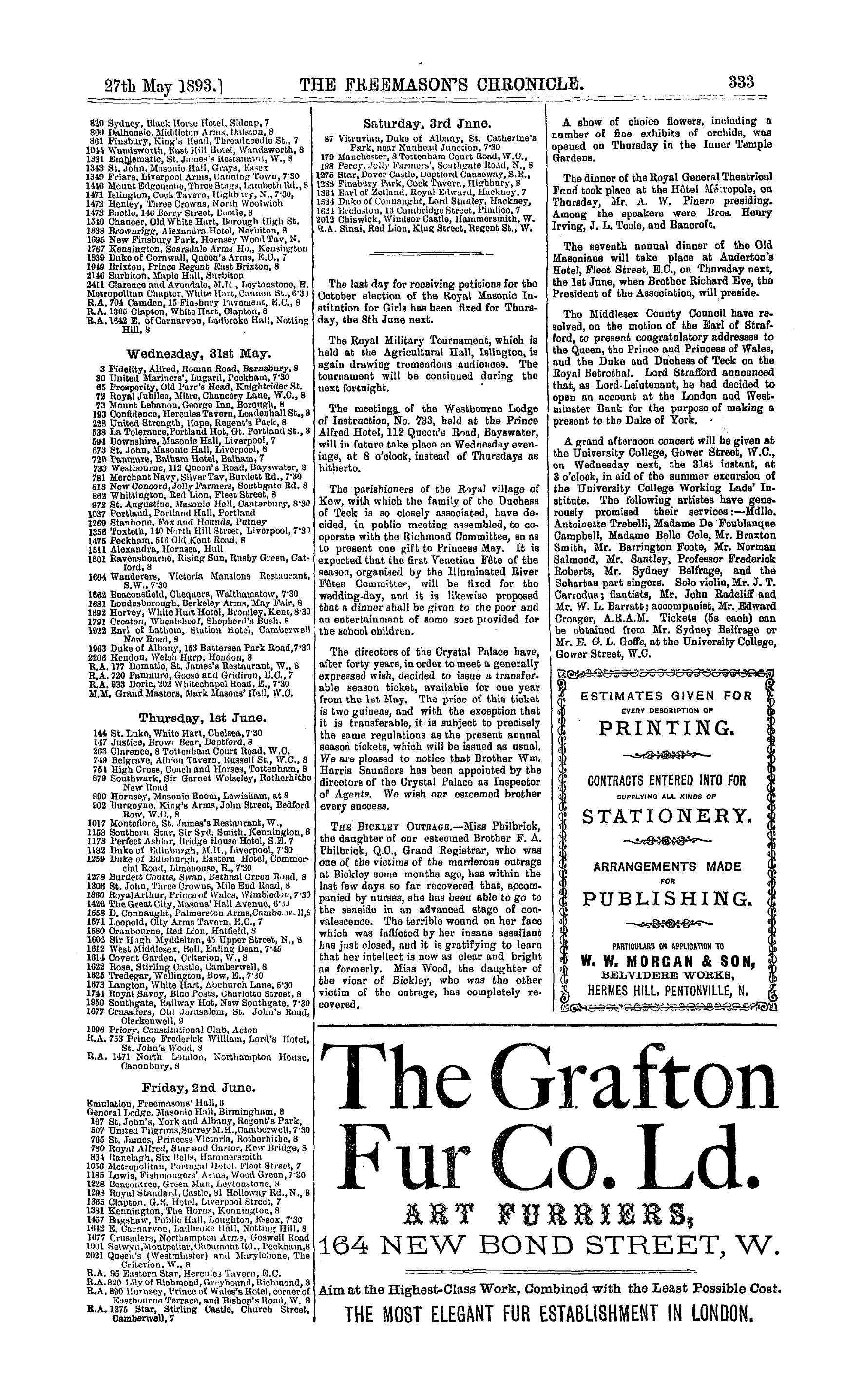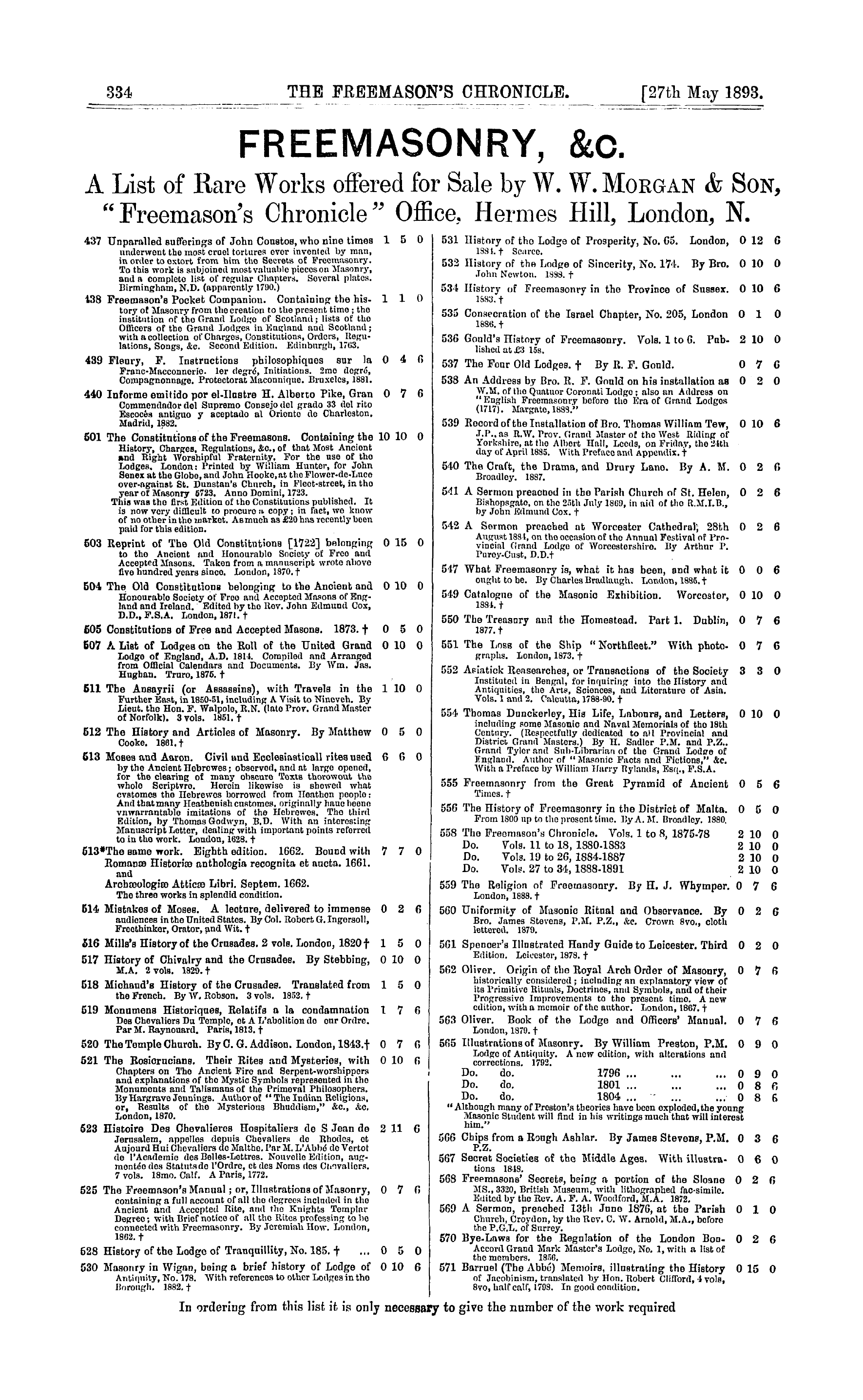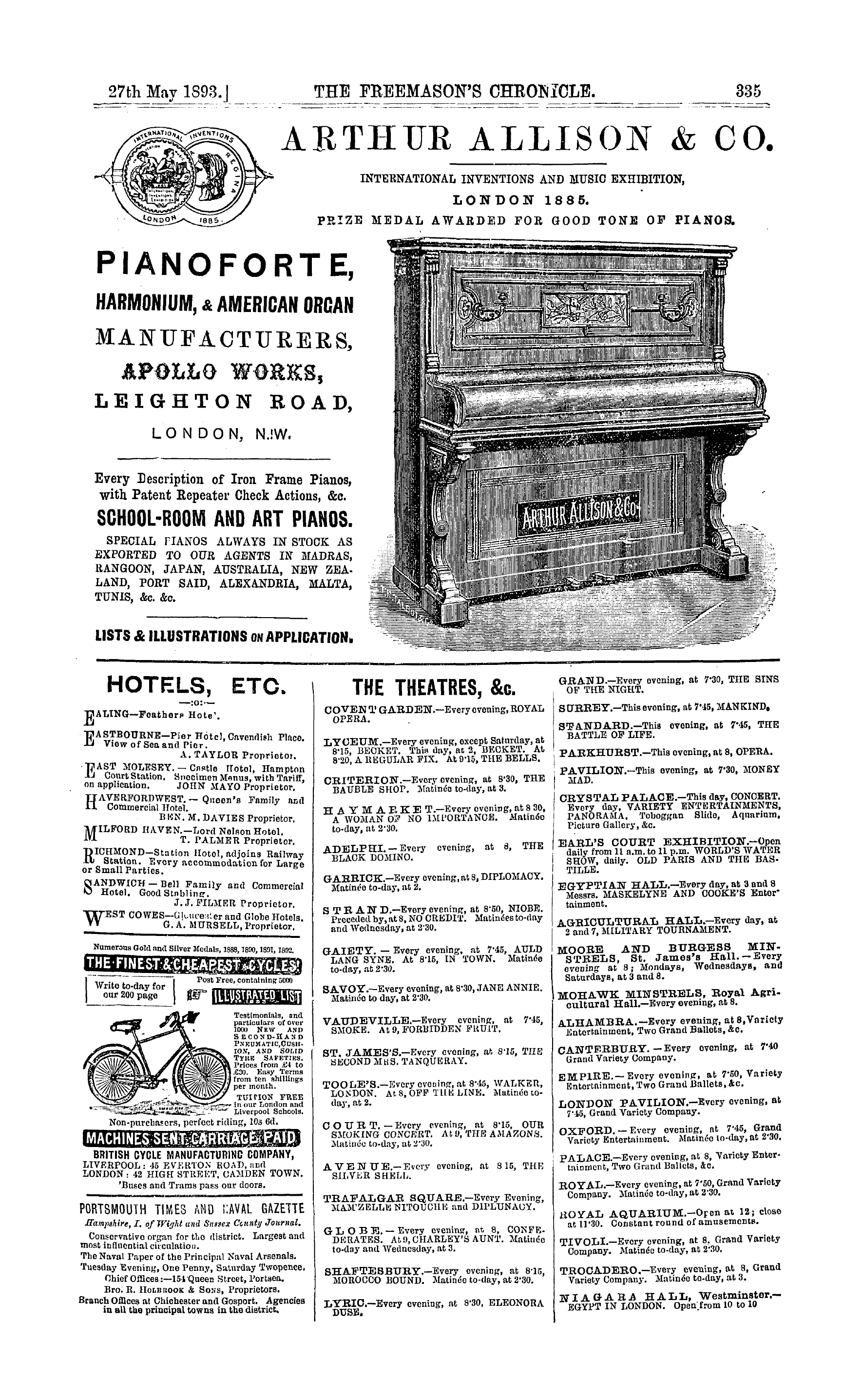-
Articles/Ads
Article MASONRY'S ANTIQUITY AND SIGNIFICANCE. ← Page 3 of 3
Note: This text has been automatically extracted via Optical Character Recognition (OCR) software.
Masonry's Antiquity And Significance.
well be doubted which of tho many Sts . John known to mediaeval Masonry were they to whom Lodges were dedicated , if to either : or whether the peculiar reference to the Baptist and tho Evangelist was not one of tho innovations ihat since the year 1717 have crept into English
Masonry . Willi porhnps as near an approach to the full symbolism of an emblematical representation , we might refer to the two great pillnrs that stood in the porch of the Temple , between which tho Appventice had to pass before ho became a Craftsman , whilo the point within the
circle may be symbolised , the unseen eye ever following him as he circumscribes his passions ^ with tho radius of duty , or still again , that tho point within the circlo represented the Supreme Being ; the circle indicated tho annual circuit
of the sun , and the parallel lines marked out the tropical boundaries within which that circlo is limited . The Mason subjecting himself within due bounds , in imitation of the apparent course of that glorious luminary , can never wander from the path of duty .
These explanations , however , belong not to the philosophy of Masonry ; they aro a part of its ethical aud moral teachings only , which we sip from its grand parterre of sweet and unknown flowers , even as the bee does from the field , whose unknown beauties it converts into the nutritious honey and the cementing wax .
No matter when Masonry originated—whether God-sent , as is the light which no deluge obscured , and no human misery can render less effulgent except as tho human eye is contracted to obscure its rays ; or whether dating back from the ancient mysteries , with which , in legends , in
ceremonies and in traditions , it is so strangely affiliated ; or whether only dating from the seventh century before the Christian era , and deriving its existence from the colleges of workmen—the artifices Bomanorum—who wrought in Operative and Speculative Masonry
alikethere can bo no question that the operative and speculative mind of the past few centuries has laid hold upon the mighty traditions of the past , and availed itself of that grand symbolism with which the earliest races of the world were familiar , to a greater or less degree , as expressive of
the contest throughout life of the principles of good and evil—the existence and superintendence of the Great Creator , and of the final success of truth and good and light , over falsehood and vice and darkness . In commoin life even we speak by parables , by symbols and comparisons .
And yet words do not express the highest and purest emotions cf the soul . Language , at best , is but an imperfect medium of expression . When the recluse with some simple formula points to the symbol of her faith , or the poor outcast strikes his breast with his hand—his onl y
exclamation " God be merciful to me , a sinner , ' is not tho symbol or the gesture even more eloquent than the ejaculation ? Language , it has been said , can utter well and distinctly only what is finite and limited , but symbols shadow forth the infinite aud everlasting ! Beneath them
lie the unfathomable deeps of Eternal Truth . God reveals Himself to man not through any verbal machinery or spoken speech which address the reasoning faculties , but through symbols which speak to the soul ! The world , with its
canopy of stars , audits drapery of gold-fringed clouds , and all that it contains of beauty and of grandeur , is a symbol of God , through which He speaks to human hearts and brings them into a divine sympathy with Himself .
Symbols are indeed the speech of Jehovah ! In them spake that great Reformer who , eighteen centuries ago , came upon earth to illumine darkened nations as with a sun of righteousness . Millions worship Him , and with reverential awe as part of the Godhead ; others look on him as
an inspired prophet , as Moses was before Him , and Mahomet afterwards ; others again , as simply the just and pure Son of Man who came among Hia brethren to ameliorate the woes of the common people , to teach them a new law of love ; to show them by His example what no man had ever
before shown—that when reviled , He reviled not again ; that when smitten , He smote not ; and when expiating His supposed guilt against the laws of Rome and tho authority of the Pharisees , He died with eyes uplifted , and utterances breathing only , " Father , forgive them ; they know not what
they do ! " Divine or . human , that Reformer was a world ' s great martyr ; for He died with love to His enemies , in submissive defence of what He believed to be true : without a
stain on His unseamed garments , or leaving a memory behind Him , except of the blessings that have followed the extension of His faith . With particular forms or tenets of religion Masonry has
nought to do . Around'her altars kneel tho Persian who turns in prayer to the rising sun ; the Mohammedan who believes in Moses , in Jesus , and in Mahomofc , also ; the Israelite who yet looks for a Messiah , and the Christian
who believes tbat the present dispensation closes the world's history—to be ended only with thoso grand changes which God will evoko according to his own inscrutable will from the past , and which we all , as wo kneel around our Masonic altars—of whatovor faith or
creed—believing to bo tho workings of a great , overruling Providence , looking to the final triumph of truth and right , " from evil still educing good . " The solstitial days of June and December were marked peculiarly by tho adopts in tho ancient mysteries , as
commemorative of great ideas . Tho Hierophants , thoso who spake the saced language , and were versed in all tho knowledge and traditions of the East , worshipped not the sun whoso mysteries they celebrated . The sun was but a symbol of the Great Creator , the latchets of whose shoes
of light that luminary but feebly unloosens every day . The Hierophants had a hidden language , and their mysteries were intended to conceal hidden truth . Yearly they celebrated the triumph of the good , as tho sun shono
in its summer solstice . It reigned three days , and during that time they celebrated their grand symbolism . Gradually the sun swept southward , and , passing the East , came to the point where for threo days it remained in tho darkness of winter . Then came the December
anniversary . The emblem of light rose from its symbolic grave , and with it men ' s energies were directed to a new year ' s life . These were annual celebrations . In succeeding to them , or in adopting their peculiar illustrations , Masonry however acknowledged no decline . It only
celebrated its days of triumph and of resurrection for good , its solstitial grandeur , and the day when with garments purified it rose from its sleep to new energy and exertion . The latter days of June and December were admitted to be those days in the natnral
world . Por eighteen centuries Masonry has availed itself of these emblems . Venerating the example of the great Essene , commonly known as the Baptist , because ho made known to the Israelites a portion of the traditions of that ancient society—who preached in the wilderness , clothed
with the peculiar insignia of his mission , and whose baptism—an Essene rite—Jesus accepted ; and venerating further the teachings of the Evangelist , who drew from the grand fountains of Eastern imagery a rushing stream of poetic eloquence , descriptive of the symbolic contest
between good and evil , the destruction of the latter , and the descent from heaven to earth of a new Jerusalem—Masonry draws its solemn instructions . The anniversaries of the Baptist and the Evangelist occur nearly at those peculiar periods which the fathers of the mysteries
celebrated as expressive of the suns course ; and modern Mason ' s in celebrating these ancient anniversaries , disregarding the old significations and allusions , innocently , and honestly , to wise advantage , appropriated them to express other ideas with which , during the medieval times of
Europe , they had become more familiar . By neither Jew or Gentile can the Saints John ever be forgotten . The one was an Essenic leader , and heralded the pure Masonic faith , as its precursor ; the other wrote of the glories of its final triumph .
Truth dawns npon the human Bonl , And error disappears ; No longer darkness hath control , From heaven ' s bine face the storm-olouds roll ,
And all the glittering years No longer for men ' s sorrow groan ; Then sin , then shame , then tears ; Bnt still and stately , part God's throne , March onward , where love reigns alone .
That snn is risen , is here ; that day Ianow to Goo * . We wait . . . The world and stars wait . . . The array of agea Stretching far away ; The angel at God's gate ,
And ancient timo ... all wait the light , Sure as God ' s Truth , though late ; When sin no more the world shall blight , Bat endless day dethrones the night . ( To be continued ) .
Saturday , the 27 th inst ., has been appointed for the private view of the summer exhibition ( the thirtieth ) of the 19 th Contnry Art Society , at the Condait Street Galleries , and tho exhibition will open to the public on Monday , the 29 th inst .
Note: This text has been automatically extracted via Optical Character Recognition (OCR) software.
Masonry's Antiquity And Significance.
well be doubted which of tho many Sts . John known to mediaeval Masonry were they to whom Lodges were dedicated , if to either : or whether the peculiar reference to the Baptist and tho Evangelist was not one of tho innovations ihat since the year 1717 have crept into English
Masonry . Willi porhnps as near an approach to the full symbolism of an emblematical representation , we might refer to the two great pillnrs that stood in the porch of the Temple , between which tho Appventice had to pass before ho became a Craftsman , whilo the point within the
circle may be symbolised , the unseen eye ever following him as he circumscribes his passions ^ with tho radius of duty , or still again , that tho point within the circlo represented the Supreme Being ; the circle indicated tho annual circuit
of the sun , and the parallel lines marked out the tropical boundaries within which that circlo is limited . The Mason subjecting himself within due bounds , in imitation of the apparent course of that glorious luminary , can never wander from the path of duty .
These explanations , however , belong not to the philosophy of Masonry ; they aro a part of its ethical aud moral teachings only , which we sip from its grand parterre of sweet and unknown flowers , even as the bee does from the field , whose unknown beauties it converts into the nutritious honey and the cementing wax .
No matter when Masonry originated—whether God-sent , as is the light which no deluge obscured , and no human misery can render less effulgent except as tho human eye is contracted to obscure its rays ; or whether dating back from the ancient mysteries , with which , in legends , in
ceremonies and in traditions , it is so strangely affiliated ; or whether only dating from the seventh century before the Christian era , and deriving its existence from the colleges of workmen—the artifices Bomanorum—who wrought in Operative and Speculative Masonry
alikethere can bo no question that the operative and speculative mind of the past few centuries has laid hold upon the mighty traditions of the past , and availed itself of that grand symbolism with which the earliest races of the world were familiar , to a greater or less degree , as expressive of
the contest throughout life of the principles of good and evil—the existence and superintendence of the Great Creator , and of the final success of truth and good and light , over falsehood and vice and darkness . In commoin life even we speak by parables , by symbols and comparisons .
And yet words do not express the highest and purest emotions cf the soul . Language , at best , is but an imperfect medium of expression . When the recluse with some simple formula points to the symbol of her faith , or the poor outcast strikes his breast with his hand—his onl y
exclamation " God be merciful to me , a sinner , ' is not tho symbol or the gesture even more eloquent than the ejaculation ? Language , it has been said , can utter well and distinctly only what is finite and limited , but symbols shadow forth the infinite aud everlasting ! Beneath them
lie the unfathomable deeps of Eternal Truth . God reveals Himself to man not through any verbal machinery or spoken speech which address the reasoning faculties , but through symbols which speak to the soul ! The world , with its
canopy of stars , audits drapery of gold-fringed clouds , and all that it contains of beauty and of grandeur , is a symbol of God , through which He speaks to human hearts and brings them into a divine sympathy with Himself .
Symbols are indeed the speech of Jehovah ! In them spake that great Reformer who , eighteen centuries ago , came upon earth to illumine darkened nations as with a sun of righteousness . Millions worship Him , and with reverential awe as part of the Godhead ; others look on him as
an inspired prophet , as Moses was before Him , and Mahomet afterwards ; others again , as simply the just and pure Son of Man who came among Hia brethren to ameliorate the woes of the common people , to teach them a new law of love ; to show them by His example what no man had ever
before shown—that when reviled , He reviled not again ; that when smitten , He smote not ; and when expiating His supposed guilt against the laws of Rome and tho authority of the Pharisees , He died with eyes uplifted , and utterances breathing only , " Father , forgive them ; they know not what
they do ! " Divine or . human , that Reformer was a world ' s great martyr ; for He died with love to His enemies , in submissive defence of what He believed to be true : without a
stain on His unseamed garments , or leaving a memory behind Him , except of the blessings that have followed the extension of His faith . With particular forms or tenets of religion Masonry has
nought to do . Around'her altars kneel tho Persian who turns in prayer to the rising sun ; the Mohammedan who believes in Moses , in Jesus , and in Mahomofc , also ; the Israelite who yet looks for a Messiah , and the Christian
who believes tbat the present dispensation closes the world's history—to be ended only with thoso grand changes which God will evoko according to his own inscrutable will from the past , and which we all , as wo kneel around our Masonic altars—of whatovor faith or
creed—believing to bo tho workings of a great , overruling Providence , looking to the final triumph of truth and right , " from evil still educing good . " The solstitial days of June and December were marked peculiarly by tho adopts in tho ancient mysteries , as
commemorative of great ideas . Tho Hierophants , thoso who spake the saced language , and were versed in all tho knowledge and traditions of the East , worshipped not the sun whoso mysteries they celebrated . The sun was but a symbol of the Great Creator , the latchets of whose shoes
of light that luminary but feebly unloosens every day . The Hierophants had a hidden language , and their mysteries were intended to conceal hidden truth . Yearly they celebrated the triumph of the good , as tho sun shono
in its summer solstice . It reigned three days , and during that time they celebrated their grand symbolism . Gradually the sun swept southward , and , passing the East , came to the point where for threo days it remained in tho darkness of winter . Then came the December
anniversary . The emblem of light rose from its symbolic grave , and with it men ' s energies were directed to a new year ' s life . These were annual celebrations . In succeeding to them , or in adopting their peculiar illustrations , Masonry however acknowledged no decline . It only
celebrated its days of triumph and of resurrection for good , its solstitial grandeur , and the day when with garments purified it rose from its sleep to new energy and exertion . The latter days of June and December were admitted to be those days in the natnral
world . Por eighteen centuries Masonry has availed itself of these emblems . Venerating the example of the great Essene , commonly known as the Baptist , because ho made known to the Israelites a portion of the traditions of that ancient society—who preached in the wilderness , clothed
with the peculiar insignia of his mission , and whose baptism—an Essene rite—Jesus accepted ; and venerating further the teachings of the Evangelist , who drew from the grand fountains of Eastern imagery a rushing stream of poetic eloquence , descriptive of the symbolic contest
between good and evil , the destruction of the latter , and the descent from heaven to earth of a new Jerusalem—Masonry draws its solemn instructions . The anniversaries of the Baptist and the Evangelist occur nearly at those peculiar periods which the fathers of the mysteries
celebrated as expressive of the suns course ; and modern Mason ' s in celebrating these ancient anniversaries , disregarding the old significations and allusions , innocently , and honestly , to wise advantage , appropriated them to express other ideas with which , during the medieval times of
Europe , they had become more familiar . By neither Jew or Gentile can the Saints John ever be forgotten . The one was an Essenic leader , and heralded the pure Masonic faith , as its precursor ; the other wrote of the glories of its final triumph .
Truth dawns npon the human Bonl , And error disappears ; No longer darkness hath control , From heaven ' s bine face the storm-olouds roll ,
And all the glittering years No longer for men ' s sorrow groan ; Then sin , then shame , then tears ; Bnt still and stately , part God's throne , March onward , where love reigns alone .
That snn is risen , is here ; that day Ianow to Goo * . We wait . . . The world and stars wait . . . The array of agea Stretching far away ; The angel at God's gate ,
And ancient timo ... all wait the light , Sure as God ' s Truth , though late ; When sin no more the world shall blight , Bat endless day dethrones the night . ( To be continued ) .
Saturday , the 27 th inst ., has been appointed for the private view of the summer exhibition ( the thirtieth ) of the 19 th Contnry Art Society , at the Condait Street Galleries , and tho exhibition will open to the public on Monday , the 29 th inst .
